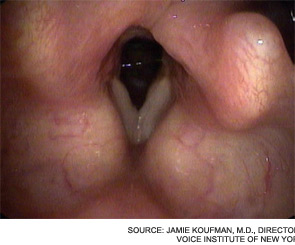Chronic laryngitis is a multifactorial disease with a large differential diagnosis for the patient who presents with hoarseness. Fortunately, the diagnosis of inflamed larynx has improved in recent years.
Explore This Issue
September 2010Robert Sataloff, MD, professor and chair of otolaryngology-head and neck surgery at Drexel University College of Medicine in Philadelphia, said progress has included a growing understanding of the anatomy and physiology of the larynx; improved visualization with strobovideolaryngoscopy, videokymography and high-speed video; an improved understanding of laryngopharyngeal reflux (LPR); and the recognition of the role played by certain medications, such as steroid inhalers used for the long-term treatment of asthma.
Seth Dailey, MD, associate professor of otolaryngology-head and neck surgery at the University of Wisconsin in Madison, said gastric reflux multichannel intraluminal impedance testing, coupled with esophageal pH monitoring, has “allowed us to understand when there are reflux events up into the esophagus and whether they are liquid or non-liquid, acid or non-acid.” He added that “we can begin to understand if there is a strong, intermediate or weak correlation between those events and the patient’s symptoms,” which may aid decision for more aggressive therapy such as a Nissen fundoplication.
According to Dr. Dailey, the 24-hour pharyngeal pH probe has provided reliable enough measurements of pH pharynx secretions for otolaryngologists to gauge acid exposure.
“Within the last three years, the American Academy of Otolaryngology-Head and Neck Surgery has promoted more coalescent understanding of the unified airway,” said Kenneth Altman, MD, PhD, director of the Eugen Grabscheid, MD, Voice Center at Mount Sinai School of Medicine in New York. He cited the concept that aerodigestive disease is a multifactorial problem that can require collaboration with other specialists, such as pulmonologists, allergists and gastroenterologists.

Dr. Altman added that “if the patient doesn’t respond based upon empiric treatment from your clinical judgment, then objective tests are important to determine the underlying cause of chronic laryngitis. For example, if you’re thinking of acid reflux, a screening test would be a barium swallow, but a more objective test would be 24-hour impedance and pH probe,” he said. “If you’re thinking about upper respiratory disease, a screening test would be a RAST [radioallergosorbent test], but more formal evaluation would be by an allergist with a CT [computed tomography] scan of the sinuses.”
Adding to faster diagnoses is the availability of subspecialists. “I believe the biggest advance in recent years has been the creation of new voice centers and the training of new laryngologists, allowing for better delivery of voice care,” said Adam Klein, MD, assistant professor of otolaryngology-head and neck surgery at Emory University Voice Center in Atlanta.
Hot-Button Diagnosis
While otolaryngologists are gaining a better understanding of chronic laryngitis, the potential for overdiagnosis of LPR concerns some otolaryngologists.
Leave a Reply